
Tarentola mauritanica, known as the common wall gecko, is a species of gecko (Gekkota) native to the western Mediterranean area of North Africa and Europe. It has been introduced to Madeira and Balearic Islands, and the Americas. A nocturnal animal with a predominantly insectivorous diet, it is commonly observed on walls in urban environments in warm coastal areas; it can be found further inland, especially in Spain where it has a tradition of cohabitation with humans as an insect hunter. A robust species, up to 15 centimetres (5.9 in) long, its tubercules are enlarged and give the species a spiny armoured appearance.
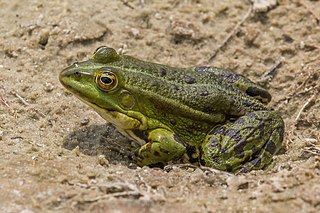
The marsh frog is a species of water frog native to Europe and parts of western Asia.
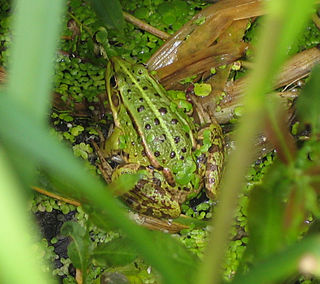
The pool frog is a European frog in the family Ranidae. Its specific name was chosen by the Italian herpetologist Lorenzo Camerano in 1882, in order to honour his master Michele Lessona.
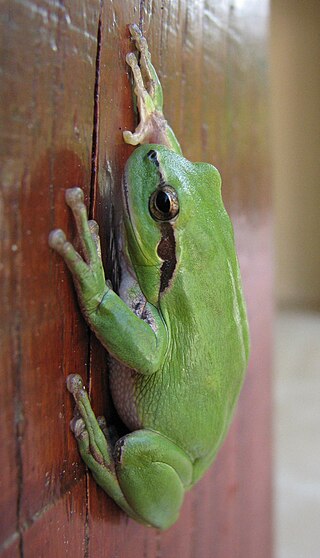
The Mediterranean tree frog, or stripeless tree frog, is a species of frog found in south-west Europe and north-west Africa. It resembles the European tree frog, but is larger, has longer hind legs, and the flank stripe only reaches to the front legs. The croaking resembles that of H. arborea, but it is deeper and slower.

Pelophylax nigromaculatus, is a species of true frog found in East Asia, first described in 1861. This widespread and common frog has many common names, including dark-spotted frog, black-spotted pond frog, and black-spotted frog.

The North African fire salamander is a species of salamander in the family Salamandridae found in Algeria, Morocco, Ceuta, and possibly Tunisia. Its natural habitats are temperate forests, rivers, and caves. It is threatened by habitat loss.
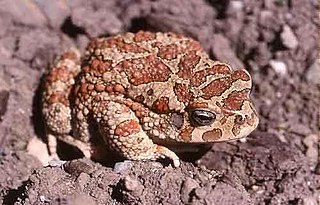
The Berber toad, also known as Mauritanian toad, Moroccan toad, pantherine toad or Moorish toad, is a species of toad in the family Bufonidae, which is found in north-western Africa, with an introduced population in southern Spain.

The Italian pool frog is a species of frog in the family Ranidae. Found on the mainland of Italy and the Mediterranean islands of Sicily, Elba, Corsica and Sardinia, its natural habitats are rivers, swamps, freshwater lakes and freshwater marshes. It is not considered threatened by the IUCN.

The Epirus water frog is a species of frog in the family Ranidae. It is found in western Greece, including Kerkyra, and the southern areas of Albania. The species is collected from the wild for human consumption.

The common green frog is a frog species of in the true frog family Ranidae; some sources still use the old name Rana erythraea. It lives in Southeast Asia and is also known as green paddy frog, red-eared frog or leaf frog. The last name, however, commonly refers to the Neotropical tree frogs which make up the subfamily Phyllomedusinae. These are not closely related to H. erythraea, belonging to family Hylidae instead.

The Perez's frog, also known as Iberian waterfrog, Iberian green frog or Coruna frog, is a species of frog in the family Ranidae. It is native to southern France, Portugal, Spain, and has been introduced to the Canary and Balearic Islands, Madeira, the United Kingdom, and the Azores. In the Iberian Peninsula it is widespread and common.

The Albanian water frog is a species of true frog and is native to Albania and Montenegro. As its common name suggests, it prefers aquatic environments. The Albanian water frog is an endangered species and known populations are currently in decline. Significant threats to its habitat are presented by pollution and by drainage of wetlands, and a more direct threat is the aggressive collection of the species for commercial purposes.
Pelobates varaldii, the Moroccan spadefoot toad, Moroccan spadefoot, or Varaldi's spadefoot toad, is a species of frog in the family Pelobatidae. As currently known, it is endemic to the coastal north-western Morocco, although there is an unconfirmed record from the Spanish territory of Melilla that could possibly represent this species. The specific name varaldii honours Marcel Varaldi who collected amphibians and reptiles in Morocco.
Saurodactylus mauritanicus is a species of gecko in the Sphaerodactylidae family found in Morocco, Western Sahara, and possibly Algeria. Both this species and Saurodactylus brosseti were both commonly known as the Morocco lizard-fingered gecko, and were both considered conspecific. Its natural habitats are temperate forests, rocky areas, arable land, and pastureland. It is threatened by habitat loss.

The Mediterranean dry woodlands and steppe is a Mediterranean forests, woodlands, and scrub ecoregion of North Africa. It occupies interior plateaus and mountain ranges of the Maghreb region, lying generally between the coastal Mediterranean woodlands and forests to the north and the Sahara to the south.
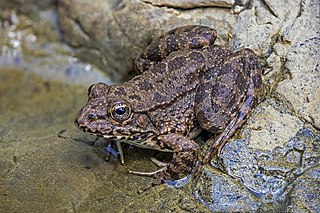
Pelophylax is a genus of true frogs widespread in Eurasia, with a few species ranging into northern Africa. This genus was erected by Leopold Fitzinger in 1843 to accommodate the green frogs of the Old World, which he considered distinct from the brown pond frogs of Carl Linnaeus' genus Rana.
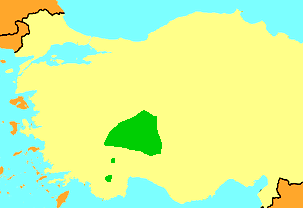
Pelophylax caralitanus, commonly known as the Anatolian frog or Beyşehir frog, is a species of frog in the family Ranidae. It is endemic to southern Turkey where it has a moderately large range and is considered near-threatened by the International Union for Conservation of Nature.
Chalcides boulengeri, also known commonly as Boulenger's feylinia and Boulenger's wedge-snouted skink, is a species of lizard in the family Scincidae. The species is native to the Maghreb region of North Africa.

















